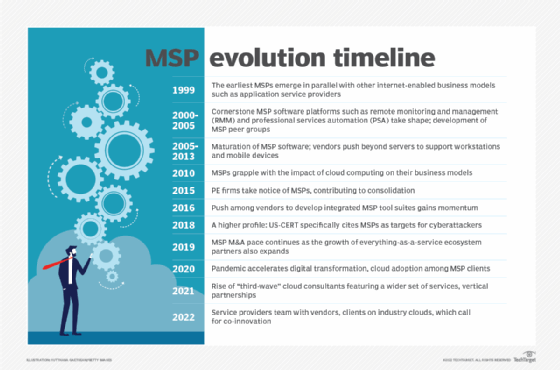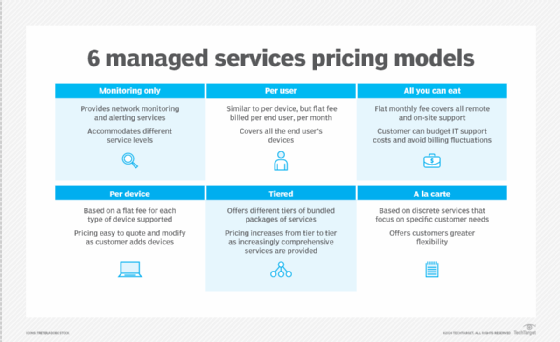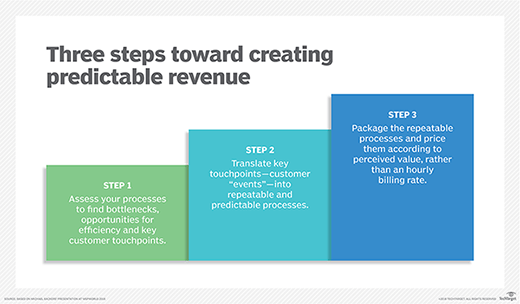Guide to building and executing an MSP business model
This managed service guide provides an overview of the business model, covers the basics of building a service provider business and discusses how to manage a maturing operation.
The MSP business model emerged in the late 1990s, a product of the internet's meteoric rise, and has since matured into a widely recognized mechanism for delivering IT services.
Awareness of managed service providers has grown among customers, from SMBs to enterprises. MSPs are called on to provide services such as remote monitoring and management, cloud consulting and migration, and cybersecurity. The increased visibility of MSPs, and their recurring revenue streams, have made them an attractive target for investors.
Entrepreneurs planning to launch an MSP can take heart in the historically steady pace of customer demand. The MSP market saw an average annual growth rate of around 11% for the 2014-2024 period, according to industry estimates. Broader business trends have been favorable for service providers' revenue expansion. Organizations across a range of industries increasingly depend on IT to offer their products and services. Those prospective customers often lack the internal IT resources to thrive in a rapidly digitalizing world -- hence the need for external service providers.
Would-be MSPs, however, must overcome several hurdles to capitalize on the demand for services. Those issues include choosing a pricing strategy, finding IT talent and marketing their services. Established MSPs, while enjoying the advantage of a mature service-delivery method, face their own set of concerns. Technology developments such as cloud computing and AI, for instance, have compelled MSPs to drastically rethink their business models and update their services. The task of building an MSP is never quite done.

Benefits and challenges
The benefits of running a managed IT services business attract newcomers and keep long-established companies in the market. Here are a few pluses:
- Predictable, recurring revenue. Managed services are sold under a subscription-based pricing model, with customers paying a monthly fee. This approach provides a consistent flow of monthly recurring revenue (MRR) for the MSP, in contrast to the unpredictability of generating revenue from one-off projects. The stability of MRR is part of what has attracted investors to the MSP sector. Although an MSP's founder might not plan to sell, it is reassuring to know that there is a viable exit strategy.
- Opportunity for higher margins. Many companies that transitioned into the MSP business model were originally resellers who bought products from hardware vendors and sold them at a markup. Those companies sought higher profitability in services as hardware margins eroded over the years. MSP business management software and various automated tools offer service providers the ability to support multiple customers with a relatively small number of employees, opening opportunities to boost profits.
- Opportunity for expanded services. MSPs that successfully launch an initial service line are poised to provide additional offerings, from IT strategy consulting to backup and recovery. Those additional services help a provider avoid customer churn because clients can meet more of their needs through the MSP without having to turn to other suppliers. Add-on services also increase the amount of revenue generated per month, per customer.
- Ability to tap mature technology. Early MSPs built their own tools or used commercially available -- but non-MSP-specific -- data center management software to run their operations. Today, MSPs have a wide range of purpose-built software products to manage their businesses. Remote monitoring and management (RMM) and professional services automation (PSA) products are among the offerings that can serve as an MSP's technology foundation.
MSPs, however, will encounter challenges along the way. The top issues include the following:
- Developing the initial offer. An early task for a startup MSP is developing and pricing the offer. There are numerous pricing models -- see the next section -- from which to choose.
- Obtaining talent. MSPs face the same recruitment and retention issues as any other technology business. The staffing challenges become more acute as MSPs venture into high-demand areas, such as cybersecurity, cloud engineering and AI.
- Marketing services. Startup MSPs mostly rely on word-of-mouth promotion and customer referrals to get off the ground. At some point, however, service providers tend to reach a plateau in which new sales just keep up with the natural rate of customer attrition. MSPs must develop a marketing plan to promote their value proposition, maintain a healthy sales pipeline and keep the company growing.
- Gearing up for vertical markets. As MSPs expand, they might choose to focus on one or a handful of vertical markets. To pursue such a strategy, a service provider might need to acquire specialized industry knowledge or develop expertise in technologies endemic to particular industries.
How to build an MSP business model
For startups, entering the managed services market requires several steps. Here's a summary:
1. Define the business strategy
Where, what and how are the first questions to answer when devising the core MSP strategy. What geographical area or areas will the company pursue? What services will the MSP provide? How will the MSP deliver the services offered? Entrepreneurs starting a service might consider focusing on a line-of-business technology, which lets the MSP deliver business value with an offering specific to a vertical market or a horizontal function. Examples include an electronic health records system for the healthcare vertical or cloud software for the marketing function. The MSP business strategy can also extend to how the MSP plans to work with customers' internal IT teams. The co-managed IT services approach, for example, aims to create a cooperative relationship between the MSP and the IT department, as opposed to an adversarial one.
2. Determine the pricing model
Pricing is an element of business strategy that deserves special attention. An MSP's pricing model provides the basis for recurring revenue. In addition, proper pricing will make it easier for customers to assess and consume a provider's offerings. An MSP can choose from at least six popular pricing models, which run the gamut from simple plans to all-encompassing packages. Which model works for an individual company will depend on the scope of the services it plans to sell and the intended customer base.

MSPs starting from nothing have a clearer path when adopting a pricing model. Companies transitioning to the MSP business model from a different approach will likely need to revamp their pricing to obtain a predictable revenue flow. Once a pricing approach has been established, MSPs must learn how to stay competitive without slashing prices. Techniques include paying close attention to labor costs and focusing on a vertical market or technical specialization that reinforces the company's value in the eyes of customers.
3. Create and offer an SLA
An MSP must offer a service-level agreement (SLA) to govern its relationships with clients. The SLA documents the services the MSP will provide, defines the standards for delivery and establishes the means for redressing issues. Service providers might also create a master service agreement, which sets forth the general terms and conditions for client work. The service agreement might incorporate the SLA by reference. SLAs help manage customer expectations and provide customers with a tool for comparing offers from different MSPs.
4. Create a sales and marketing strategy
Sales and marketing are typically not the strongest parts of an MSP's business. As noted, companies initially gain new customers through referrals rather than active selling. But service providers seeking continued business expansion will probably need to create a proactive sales and marketing effort.
Ideally, an MSP sales process would begin with hiring an experienced MSP salesperson. People with that skill set are difficult to find, so an MSP might need to hire salespeople and train them on the fundamentals of the MSP business. Another option is to have an MSP technician, in a sales engineering role, partner with a salesperson on customer calls. The sales process should be standardized, from initial contact with a prospect through order processing.
A sales and marketing strategy rests on two essentials: knowledge of self and knowledge of customer. An MSP needs to know its strengths to craft a go-to-market message. Based on that insight, a service provider can also develop a profile of the ideal customer and then focus its sales and marketing activities in that direction. Consultative selling, which zeros in on a client's pain points, is another approach that MSPs can adopt when targeting SMB customers. MSP marketing considerations include making sure website copy speaks to targeted customers, building a brand around core services and appointing one person in-house to take on marketing duties.
5. Develop a recruiting strategy
An MSP that launches with a core group of employees will eventually need to recruit talent to serve customers as it grows. An IT recruitment strategy should ideally strike a balance between looking for required skill sets and looking for personality traits that fit the organization's culture. Technical expertise, while important, isn't the whole employee picture. Service providers seeking new employees should consider an applicant's ability to cope with pressure, learn as they go and adapt to unexpected situations.
6. Determine what type of MSP to become
A startup MSP might initially concentrate on basic services, such as network monitoring and management. But it's never too early to think about a growth trajectory. A service provider should assess customer needs to determine the next steps, such as offering backup and disaster recovery or cybersecurity. Eventually, an MSP can choose to specialize in one or more areas. Here are some possibilities:
- Vertically focused MSP. Here, the MSP would acquire expertise in one or more verticals and go to market as an industry-specific service provider.
- Platform-oriented MSP. An MSP can choose to focus on a particular technology stack, public cloud infrastructure platform or SaaS offering.
- Consultative MSP. Early-stage service providers tend to focus on the technical aspects of supporting customers. Providing consulting services, however, puts MSPs in a position to address business concerns. MSPs can evolve to the point of offering a virtual CIO service.
- Managed security services provider. An MSSP offers a range of services to help customers address security, privacy and compliance issues. While MSSPs specialize in security, MSPs increasingly offer at least some security features.
- White-label service provider. An MSP, at some point in its development, might decide to offer its infrastructure to smaller MSPs. This MSP business model variation can provide a range of offerings, including network operations center services, staff augmentation and cybersecurity.
Executing the MSP business model
The task for start-up service providers shifts from planning to execution once the MSP business model is in place.
Client onboarding is a key element of bringing a business model to life. The customer relationship depends on this early step. MSPs should document and standardize the onboarding process to make it consistent. Client onboarding typically involves several actions, including assessing the client's IT infrastructure and tools and identifying specialized requirements with respect to specific technologies or vertical markets. The process also aims to provide a smooth transition for the customer along the relationship continuum, from presales and sales to ongoing operations. MSP employees involved in the process can include an onboarding manager and customer advocates.
Operational efficiency is directly tied to realizing the key benefits of the MSP model -- namely, the opportunities for recurring revenue and higher margin. An MSP that fails to deliver quality services or struggles with keeping labor costs in check will have a tough time retaining customers or turning a profit.
Specialized management software and automation are fundamental to sustaining an MSP business. RMM software, the technology cornerstone for most MSPs, lets service providers remotely manage their customers' on-premises gear -- from servers to mobile devices -- as well as cloud-based IT infrastructure. PSA software tools, meanwhile, automate an MSP's core business functions, playing a role like that of ERP in other types of businesses. PSA functionality varies from one software vendor to another, but typical functions include time and billing, ticketing, project management, financial management and reporting/analytics.
Although RMM and PSA serve as the technology underpinning for many MSPs, those products aren't the only approaches service providers employ. Other companies use SaaS monitoring tools, IT service management offerings, observability platforms or CRM products, for example. MSPs also use cloud service providers' native cloud monitoring tools.
Evolving a mature MSP business
An established service provider can expect to transform its business model every few years and must tweak its service mix on an ongoing basis. The pattern is nothing new for channel companies that have evolved from resellers to solution providers to MSPs over the past 40 years.
The pace of change, however, has accelerated in recent years. MSPs that launched in the 2000s had to reinvent their services in the 2010s to accommodate cloud computing: Service providers that once focused on remotely managing clients' servers started managing clients' cloud-based infrastructure and applications. By the 2020s, cloud platform providers such as AWS, Google and Microsoft Azure had become the channel partner ecosystems' top vendor allies.
MSP must also adapt to macroeconomic patterns and unpredictable events, as well as technological developments. One example is the COVID-19 pandemic, which led service providers to rapidly roll out services to help customers accommodate newly remote employees. The post-pandemic inflationary trend prompted MSPs to offer cost optimization and FinOps consulting services for customers struggling to reduce IT spend.
The mainstream arrival of generative AI (GenAI) in late 2022 was yet another sweeping change that required MSPs to adjust their business models. Service providers continue to deal with the rise of GenAI and have identified agentic AI as among the top trends of 2025. As of the first half of 2025, MSPs were also considering the economic effects of the Trump administration's tariff plan and other nations' countermeasures.
Service providers can pursue several methods to help them adapt to change and absorb unexpected developments:
- Offer a diversified portfolio of services. During the COVID-19 pandemic, for example, businesses had to adopt collaboration tools, adjust security policies in light of remote work and migrate more operations to the cloud. Overall, the pandemic's financial lessons favored service providers with broader portfolios that provided a mix of collaboration, cybersecurity and cloud offerings.
- Build flexibility into operations. MSPs need flexibility to deal with the unexpected. Using methodologies such Agile and Lean Six Sigma to manage projects helps service providers guide customers through periods of change. Such approaches emphasize iterative development, letting MSPs quickly adjust to shifting business requirements and digital transformation strategies.
- Emphasize continuous learning. Technology trends can take markets by storm, so MSPs must be prepared to retrain employees. Service providers did just that amid the rise of GenAI, committing to train more than 1 million consultants on the technology. Reskilling methods include employee development programs, product-specific training from AI technology companies and online learning platforms.
- Adopt AI to boost efficiency, decision-making. AI has the potential to revamp the traditional MSP approach of monitoring customers' IT resources and responding to incidents as they occur. AI's predictive capabilities, however, can identify early signs of trouble and let MSPs prevent incidents from occurring. Minimizing the time required to troubleshoot and resolve issues reduces labor costs, while improving customer satisfaction. In addition, using AI to automate onerous tasks such as document management can boost profitability. Generative AI, meanwhile, analyzes large amounts of data to provide additional benefits, helping MSPs identify trends, automate research and inform decision-making. Those advantages could prove particularly useful for a service provider's business development and consulting activities.
- Update pricing models. MSPs should consider their pricing models as they build more flexible operations. Adopting value-based pricing, for example, lets an MSP set pricing based on how it believes customers value its complete roster of services. In contrast to per-user or per-device methods, value-based pricing shifts the focus to customers' business outcomes, such as increased efficiency. This approach connects services to measurable results, which helps clients justify spending in challenging economic times. Value-based pricing also aligns with emerging technologies such as agentic AI, which lends itself to outcome-based measures such as task completion.

In general, an MSP should be prepared to embrace change. Periodic business model transformation can prove expensive to execute and disruptive to employees and clients. But it's the cost of participating in a dynamic market.
John Moore is a writer for Informa TechTarget covering the CIO role, economic trends and the IT services industry.






